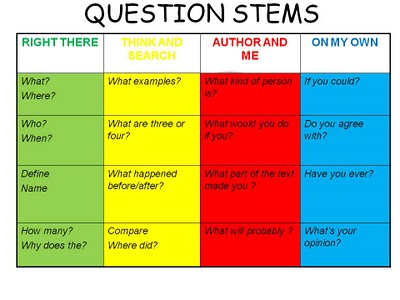

Getting the GIST: a Summarizing Strategy for any Content Area The lesson makes use of a “stop point” technique, whereby the teacher inserts “stop points” into a document at which point students write a question. This lesson plan provides a detailed step-by-step guide that helps you teach students to effectively use the QAR system to improve their own reading. Using QARs to Develop Reading Comprehension and Reflective Reading Habits This lesson guides students to work in groups to write quiz questions for stories they have read, then “administer” the quizzes to other groups of students.

The same student then “becomes” a different character and lists traits of the first character from his own, (the second character’s) perspective.Īctive Reading through Self-Assessment: The Student-Made Quiz Students “become” a character in a book or story and list adjectives that would describe him/her. This lesson on the 6-8 grade band sounds extremely promising for helping students both work on vocabulary to describe characters and helping students analyze characters by considering actions, dialogues, and behavior. Reading Lessons Action is Character: Exploring Character Traits with Adjectives Each of the lessons come with handouts, from which you’ll see excerpts below. The teachers who have submitted these lessons have clearly worked extensively with real students and know that a creative approach to foster engagement is very important.īelow are some highlights from the lesson plans, subdivided into the categories of Reading Lessons and Vocabulary Lessons. While many lesson plans would need adaptation for the adult ed classroom, there are some really wonderful and innovative approaches here. Often lessons link to other internet resources. The site provides both a very large bank of lesson plans searchable by grade and topic, and a set of Strategic Guides on different teaching approaches (Teaching with Technology, Developing Academic Vocabulary, Reading in the Content Areas, etc.) which are helpful as well.Įach lesson plan includes an overview, a detailed instructional plan, downloadable resources and handouts for teaching the lesson, and research articles that support the approach. Meet them here.This behemoth of a site may seem overwhelming at first, but can provide useful resources for adult educators. Whether they are working in the classroom, the library, or the media lab, our authors all have one thing in common: a passion for literacy learning. The content on ReadWriteThink is created by a diverse group of educators who share a passion for literacy learning. ReadWriteThink is able to offer all of this great content because of the literacy experts who write and review for us and are committed to providing our users with the highest quality practices in reading and language arts instruction.


READWRITE THINK QAR OFFLINE
ReadWriteThink has always had a focus on professional development - helping educators recharge their teaching, learn new techniques and strategies, and connect with other literacy professionals through both online and offline opportunities. Every lesson plan on ReadWriteThink has always been aligned to the IRA/NCTE Standards for the English Language Arts, showing how theory feeds into practice. The site has consistently been one of the most information-rich literacy resources on the internet. This includes hundreds of lesson plans, calendar resources, prints, and interactive tools.
READWRITE THINK QAR FREE
Since 2002, has provided literacy educators with access to an ever-growing collection of free educational materials. Our StandardsĮvery lesson plan on ReadWriteThinkTM has been aligned not only to the IRA/ NCTE Standards for the English Language Arts but to individual state standards and Common Core State Standards, when applicable. Here at ReadWriteThink, our mission is to provide educators, parents, and afterschool professionals with access to the highest quality practices in reading and language arts instruction by offering the very best in free materials.


 0 kommentar(er)
0 kommentar(er)
